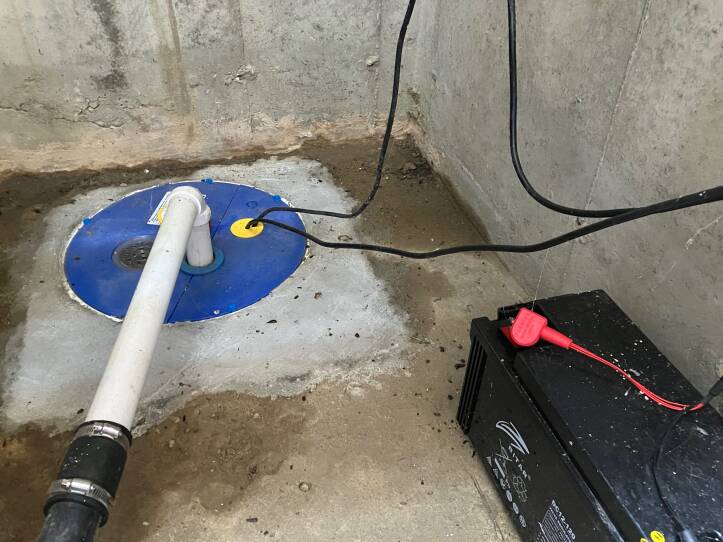Kent Hicks knows a lot more about buildings than the average homeowner. He’s a general contractor and teaches sustainable design and building technology at the University of Massachusetts Amherst.
But on the morning of August 28, 2011, Tropical Storm Irene taught even Hicks a lesson.
“I looked out the window and I saw that this hurricane thing is real. There's a lot of water [that] just got dumped,” he said.

Hicks and his wife Lynn live and work right next to the Westfield River, in an old grist mill that dates back to 1850 in West Chesterfield, Massachusetts.
Irene not only dropped a lot of water quickly, it uprooted trees. To protect the building, Hicks got into the water.
“I was pushing debris away because logs were coming down through the forest here. I was trying to guide them away,” Hicks recalled. “Until [it] got about up to my chest and I said, 'All right, I need to get out of the water.'”
The river rose about 10 feet outside. He was worried pressure from the water would push against the building and it would float away.
“It was within a few feet of lifting the building up and it would have taken it over the gorge,” he said.
Since then, Hicks has reengineered his building — in a surprising way — to let the water in.
On a recent visit, he pointed out a double set of doors that lead into his basement.
“With a flooding event, these doors will come open on this side and let water flow through here. So, I’m not trying to stop water,” he said.
Across the basement, three windows on hinges are designed to serve as additional water vents.
“The water will push them open,” he said. “It'll lift [them] up.”
The idea is to allow floodwaters to enter the house and rise and fall with the water outside so that the pressure of the water is equalized — and the house isn’t carried away.

Hicks also poured a concrete floor over a massive grid of steel, which is attached to posts that are strapped to beams. This “anchor” was designed to hold the building temporarily until the water pressure equalizes.
“It's so much water and so much force,” Hicks said about floods like the one from Irene. “It would be so difficult to keep that water out and to keep the building from collapsing with the pressure of the water.”
Some of these efforts may sound extreme. But with more precipitation in New England — and more intense storms — property owners are taking action to prevent flooding. And even FEMA recommends what it calls “wet floodproofing” in some circumstances.
FEMA's recommendations include elevating service equipment like water heaters and large appliances above the area where they could be flooded. FEMA also suggests avoiding materials like drywall in parts of a house that might get flooded. Drywall is made of paper-faced gypsum, which is vulnerable to mold when it gets wet. If that happens, homeowners would have to pull those walls out.
Hicks' design would allow floodwaters to rise from his basement into the first floor. There, instead of drywall, he installed wainscoting made of corrugated metal panels — repurposing the original roof.
“If we get a flood event in here, [the panels] can all unscrew and let [the wood and insulation] dry out,” he said. “You want to have materials that will not mold.”
But most people try to keep the water out.
Craig Leader of Dry Zone Basement Systems has been helping people do that for about 25 years by installing drains and sump pumps in basements. When Leader first started, he could count on slow periods in January, February and into March. But no more.
“Now we are running full force 12 months a year and at times gasping for air trying to keep up,” he said.
That tracks with climate data.
“Over the last about 50 years, the annual precipitation amounts have increased by about 20 to 30%, which is a tremendous amount — in New England,” said David Boutt, a UMass Amherst hydrogeologist.
Through his business, Leader is keenly aware of the impact of a changing climate.
“It's certainly happening faster than I thought it was ever going to happen, just by how our rain seasons are, our winter seasons are.” Leader said. “Everything is changing.”
His company installs systems that can withstand extreme weather. Mike Davis in Florence, Massachusetts, got one — after he had a flood.
“I had 3 inches of water in the basement, covering everything, including the furnace,” Davis said.
That was in 2011, after an October Nor’easter knocked out power for about 3 million people, including Davis. He had a sump pump, but without power it didn’t work.
So he grabbed a bucket.

“In the dark, in the cold, I filled five-gallon buckets over and over and over and lugged them to the toilet 30 feet away. That was exhausting,” he said. “It went all night. I'd set an alarm to wake me up so I could go bale some more.”
A few years ago, Davis installed a new system with three sump pumps — two on a backup battery.
“I can even test the battery,” he said, pushing a button. A high-pitched beep signals the system is functioning.
The new sump pump system cost him $3,000 out of pocket.
That personal expense is common, according to Alex Wilson of the Resilient Design Institute in Vermont. Wilson said adapting to climate change should be a high priority, but there isn’t much public funding.
“Most of the federal funding that's available is only after the fact,” he said. “In other words, you can't use that money in advance of damage.”
Wilson said insurance companies should incentivize measures to prevent flooding.
“Insurance companies would benefit from that — fewer payouts for damage and homeowners would benefit by getting these measures paid for or by having lower insurance costs if they have implemented some of these measures,” Wilson said.

Wilson said another resilience strategy — elevating mechanical equipment like furnaces and electrical panels to keep them out of floodwaters — can be expensive. But he points out most of it has a limited lifespan.
“When you're ready to replace that equipment, look at relocating it,” Wilson said.
At the same time, he said, homeowners should consider choosing to replace “fossil fuel boilers with mini splits or air source heat pumps.”
In Florence, Davis also made changes outside his house to reduce flooding. He reconfigured his gutters and replaced a concrete patio with grass.
Allowing water to filter into the ground is almost always better than having an impervious surface, according to landscape designer Rachel Lindsay from Regenerative Design Group in Greenfield, Massachusetts.
Lindsay pointed out a large tank she installed in a corner of a building in downtown Northampton.
“This is a little bit of a tight space, but you can see the gutter coming down the side of the building,” she said.
Lindsay said water used to gush out of the gutter, carving a path directly to the storm drain.
“We've installed an interrupter that's redirecting the water into this tank. The tank is then connected to a soaker hose,” she said.

The tank, a recycled molasses container from a local dairy farm, can collect about 200 gallons of water. The hose, perforated with tiny holes, releases water slowly as it snakes through a narrow garden.
Lindsay said water can cause problems when it’s concentrated.
“That's why we slow it, spread it, soak it. Water coming out of a gutter has a lot of force and it can erode soil. It can get into your basement. If you spread it out and slow it down, it's not a problem,” she said.
If water is slowed down, it can also recharge the aquifer, a good strategy for addressing another aspect of climate change — drought.
Find other stories about climate change and housing from the NENC's 2024 Earth Day series.
Copyright 2024 88.5 NEPM. To see more, visit 88.5 NEPM.




